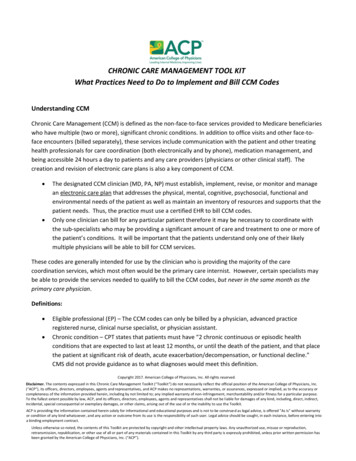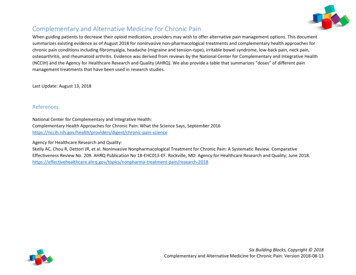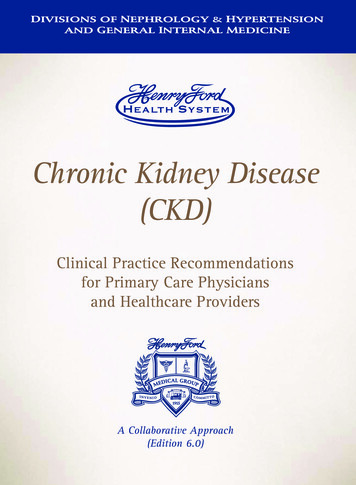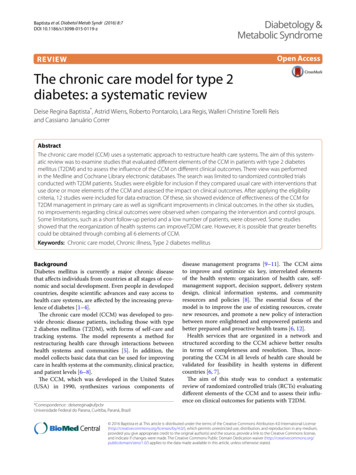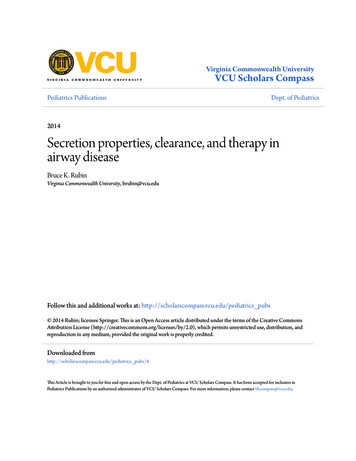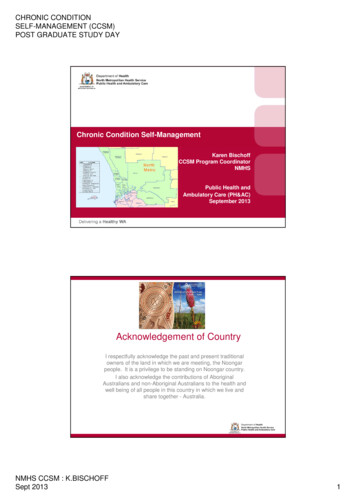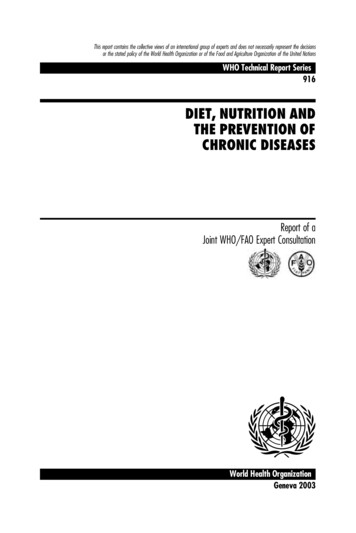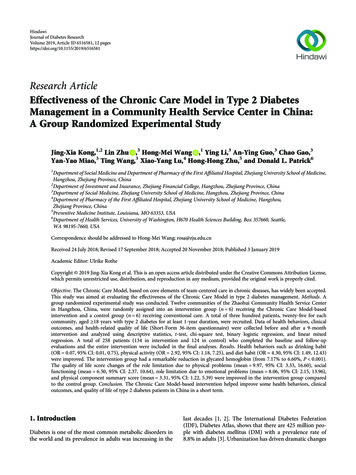
Transcription
HindawiJournal of Diabetes ResearchVolume 2019, Article ID 6516581, 12 pageshttps://doi.org/10.1155/2019/6516581Research ArticleEffectiveness of the Chronic Care Model in Type 2 DiabetesManagement in a Community Health Service Center in China:A Group Randomized Experimental StudyJing-Xia Kong,1,2 Lin Zhu ,3 Hong-Mei Wang ,1 Ying Li,3 An-Ying Guo,3 Chao Gao,3Yan-Yao Miao,3 Ting Wang,3 Xiao-Yang Lu,4 Hong-Hong Zhu,5 and Donald L. Patrick61Department of Social Medicine and Department of Pharmacy of the First Affiliated Hospital, Zhejiang University School of Medicine,Hangzhou, Zhejiang Province, China2Department of Investment and Insurance, Zhejiang Financial College, Hangzhou, Zhejiang Province, China3Department of Social Medicine, Zhejiang University School of Medicine, Hangzhou, Zhejiang Province, China4Department of Pharmacy of the First Affiliated Hospital, Zhejiang University School of Medicine, Hangzhou,Zhejiang Province, China5Preventive Medicine Institute, Louisiana, MO 63353, USA6Department of Health Services, University of Washington, H670 Health Sciences Building, Box 357660, Seattle,WA 98195-7660, USACorrespondence should be addressed to Hong-Mei Wang; rosa@zju.edu.cnReceived 24 July 2018; Revised 17 September 2018; Accepted 20 November 2018; Published 3 January 2019Academic Editor: Ulrike RotheCopyright 2019 Jing-Xia Kong et al. This is an open access article distributed under the Creative Commons Attribution License,which permits unrestricted use, distribution, and reproduction in any medium, provided the original work is properly cited.Objective. The Chronic Care Model, based on core elements of team-centered care in chronic diseases, has widely been accepted.This study was aimed at evaluating the effectiveness of the Chronic Care Model in type 2 diabetes management. Methods. Agroup randomized experimental study was conducted. Twelve communities of the Zhaohui Community Health Service Centerin Hangzhou, China, were randomly assigned into an intervention group (n 6) receiving the Chronic Care Model-basedintervention and a control group (n 6) receiving conventional care. A total of three hundred patients, twenty-five for eachcommunity, aged 18 years with type 2 diabetes for at least 1-year duration, were recruited. Data of health behaviors, clinicaloutcomes, and health-related quality of life (Short-Form 36-item questionnaire) were collected before and after a 9-monthintervention and analyzed using descriptive statistics, t-test, chi-square test, binary logistic regression, and linear mixedregression. A total of 258 patients (134 in intervention and 124 in control) who completed the baseline and follow-upevaluations and the entire intervention were included in the final analyses. Results. Health behaviors such as drinking habit(OR 0 07, 95% CI: 0.01, 0.75), physical activity (OR 2 92, 95% CI: 1.18, 7.25), and diet habit (OR 4 30, 95% CI: 1.49, 12.43)were improved. The intervention group had a remarkable reduction in glycated hemoglobin (from 7.17% to 6.60%, P 0 001).The quality of life score changes of the role limitation due to physical problems (mean 9 97, 95% CI: 3.33, 16.60), socialfunctioning (mean 6 50, 95% CI: 2.37, 10.64), role limitation due to emotional problems (mean 8 06, 95% CI: 2.15, 13.96),and physical component summary score (mean 3 31, 95% CI: 1.22, 5.39) were improved in the intervention group comparedto the control group. Conclusion. The Chronic Care Model-based intervention helped improve some health behaviors, clinicaloutcomes, and quality of life of type 2 diabetes patients in China in a short term.1. IntroductionDiabetes is one of the most common metabolic disorders inthe world and its prevalence in adults was increasing in thelast decades [1, 2]. The International Diabetes Federation(IDF), Diabetes Atlas, shows that there are 425 million people with diabetes mellitus (DM) with a prevalence rate of8.8% in adults [3]. Urbanization has driven dramatic changes
2in lifestyle particularly in developing countries, which resultsin a high incidence of obesity and related chronic diseasesincluding diabetes. As the largest developing country in theworld, China experienced a sharp increase in the incidenceof type 2 diabetes mellitus (T2DM) in the past years. Recentstudies have shown that the prevalence of diabetes in Chinahas reached nearly 11% among Chinese adults, which ismuch higher than the world average rate [3, 4]. China hasbecome the top country with the largest number of peoplewith diabetes in the world [3].The main risk factors of T2DM include alcoholconsumption, physical activity, diet, obesity, weight, bloodglucose, serum lipid, and blood pressure. These factors playimportant roles in diabetes control, the development ofdiabetic complications, and the patients’ quality of life[5–7]. Health-related quality of life (HRQoL) is a subjectiveassessment of health status, including general health, physical, emotional, cognitive, and role functioning, as well associal well-being and functioning, which received increasingattention from health professionals and general public.HRQoL, however, can be used as a useful health outcomeevaluation tool for chronic diseases such as T2DM. HRQoLis lower among adults with T2DM compared with thosewithout [8–12]. Improvements in HRQoL among patientswith T2DM had been demonstrated with the initiation ofsome antidiabetic therapies in several previous studies[13, 14] while few studies up to date have reported therelationship between T2DM management and HRQoL.Management of patients with T2DM is a growing publichealth concern because of its increased incidence and costsand complexity of care. Researchers and practitioners arechallenged to find efficient and effective ways to improvediabetes management. The Chronic Care Model (CCM),originating from a systematic research program in the UnitedStates, provides a blueprint for chronic disease management[15–18]. The CCM comprises six components that arehypothesized to affect functional and clinical outcomes associated with disease management. These six components are(1) health system—organization of health care (providingleadership for securing resources and removing barriers tocare); (2) self-management support (facilitating skill-basedlearning and patient empowerment); (3) decision support(providing guidance for implementing evidence-based care);(4) delivery system design (coordinating care processes); (5)clinical information systems (tracking progress throughreporting outcomes to patients and providers); and (6)community resources and policies (sustaining care byusing community-based resources and public health policy)[16, 17]. A central element of the CCM is the team-centeredcare approach, which facilitates and produces effective interactions between proactive primary care practice teams andempowers patients with the aim to improve processes andoutcomes in patients with chronic illnesses. Changes in multiple areas are preferred in order to improve the quality andoutcomes of diabetes care considerably. A meta-analysis studyshowed that three to four component interventions attainedstronger effect estimates than two component interventionsdid [19]. The whole model or at least some of its elementshas been increasingly accepted and implemented in manyJournal of Diabetes Researchcountries [20–22]. The effectiveness of this model in community diabetes management has also been demonstratedin studies including systematic reviews and randomizedcontrolled trials [23–25]. Studies with the CCM approachin China, however, are limited. Most community-basedinterventions for diabetes management in China mainlyfocus on patient education, team management, andself-management support [26–28]. Only one study usingcross-sectional study design addressed the relationshipbetween compliance with the CCM in community healthcenters and self-management behaviors, glycemic control,and finally the utilization of community health centers formonitoring and treating diabetes [29]. As far as we are aware,few studies in China have evaluated the relationships betweenthe application of the CCM and objective health indicatorssuch as glycosylated hemoglobin A1c (HbA1c) and subjectivehealth indicators such as HRQoL using randomized controlled trials in community health service centers.This study was therefore aimed at assessing the effects ofthe CCM-based intervention on T2DM Management Program in Hangzhou, China, which adopted five componentsof the CCM framework. We hypothesized that primary outcomes about health behaviors (smoking, drinking, physicalactivity, and diet habit) and secondary outcomes about clinical outcomes (glycemic value, blood pressure, and lipidlevel) and HRQoL would be improved in T2DM patientswho received the CCM-based intervention in communityhealth service centers.2. Methods2.1. Study Design and Subjects. A 9-month group-based randomized experimental study was designed and conducted toevaluate the effectiveness of the CCM-based intervention inT2DM management at the Zhaohui Community HealthService Center in Hangzhou, Zhejiang province, China. Thecommunity health service center covers 12 communities witha geographic area of 3.03 square kilometers. Twelve physicianteams from the Department of Chronic Disease Managementin this center serve for the 12 communities, respectively.These 12 communities were randomly assigned into anintervention group that received the CCM-based care withcomponents including health system, self-management support, decision support, delivery system design, and clinicalinformation system and a control group that receivedconventional care. Six communities were included in theintervention group and six in the control group. All physicians involved in the study received trainings on communitydiabetes management guidelines and those in the intervention group were required to complete additional training onthe CCM including knowledge, technical, and related tools.The initial sample size was calculated on the basis of an absolute difference in HbA1c of 0.4% [30]. With a two-tailedpower of 80% at a 0.05 alpha level, assuming an intraclasscorrelation coefficient (ICC) of 0.002 and taking into accounta correction factor for the clustered design, it was calculatedthat 6 21 (126) patients would be needed in each group todetect the difference. Allowing for 15% drop out rate, a totalof 290 patients need to be included. A total of 300 patients
Journal of Diabetes Researchwere finally recruited from the 12 communities, with 25 randomly sampled from eligible patients in each communitytracked by the chronic disease management information system. Inclusion criteria were an age of 18 years or older and atleast 1-year duration of T2DM. Patients with difficulties to aself-administered survey due to cognitive or reading issueswere excluded from the study. Participants completed questionnaires of demographic and clinical information, clinicallaboratory tests, and health-related quality of life at baselinein September, 2009. After 9 months’ intervention, the samequestionnaires and clinical tests were administered again inJune, 2010.2.2. Measures2.2.1. Control Group (Conventional Care). The control groupreceived conventional follow-up, which was applied everythree months by their responsible physicians through officevisits, home visits, and telephone calls. Changes in lifestyle,diabetes control, compliance to treatment, side effects ofdrugs, and target organ damage for each patient were examined and general care guidance was given.2.2.2. Intervention Group (CCM). The intervention groupreceived the five components CCM-based intervention. Thecomponent of community resources and policies was notincluded in the intervention due to poor coordinated carebetween primary and secondary care at the time of this study.(1) Health System: Stimulation of Policy-Making. Physicianswere required to enhance patients’ awareness of chronic disease management and encourage patient initiative throughpamphlets and face-to-face communication. Additional subsidies were given to the physicians every month throughoutthe intervention process by the community health servicecenter. Appropriate supervision and evaluation procedureswere also followed.(2) Self-Management Support. Self-management supportstrategies included goals setting, planning, doing, checking,and assessing. The physicians helped their patients set goalsand made monthly self-management plans. The patientsfilled in a self-management checklist semimonthly andreported it to their physicians. At the end of each month,the physicians checked each patient’s condition and helpedthe patient plan for the next month.(3) Decision Support. Decision support included implementation of the clinical guidelines, continuous medical education,and feedback of baseline medical records. The physicianshad clinical guidelines training and continuous medicaleducation provided by the community health service center.The results of patients’ baseline survey were reported totheir responsible physicians to help in better understandingcare provision.(4) Delivery System Design. Each team included a responsiblephysician, a health manager, and a public health assistant.Clear assignment of roles and tasks within the team played3an important role in the component. The primary duties ofeach team in this group were to help the patients self-managetheir diseases (by the health manager), monthly follow-up(by the responsible physician), and respond to concernsof patients and other regular tasks (by the team together).(5) Clinical Information System. The chronic disease management information system was used in the community healthservice center to provide population-based care for patientswith hypertension, diabetes, and cancer including tracking,disease management, and assessment. The system couldshare data between the community health service centerand belonging stations, also between primary and tertiarycare. Patients’ data were regularly collected to facilitate efficient and effective care. The physicians in the interventiongroup got reminders of monthly follow-up from the trackingsystem and were required to document feedback informationtimely. The physicians in the control group got remindersevery three months.2.3. Outcomes. Health behaviors were defined as the primaryoutcomes in our study. Health behaviors in this studyincluded frequent smoker who smoked one or more cigarettes a day (yes or no), frequent drinker who drank at leastonce a week, with an average intake of 25 g pure alcohol perday or above (yes or no), physical activity ( 1 time(s)/week,none), and self-reported light diet defined as low-fat diet(yes or no). Clinical outcomes and HRQoL were definedas secondary outcomes in our study. Clinical outcomesincluded body mass index (BMI), waist circumference(WC), fasting blood glucose (FBG), HbA1c, blood pressure,and serum lipid. HRQoL was assessed with a Chinese (mainland) version of the Short Form 36 (SF-36). The SF-36 is a validated [31, 32] 36-item instrument including eight scales:physical functioning (PF), role limitations due to physicalproblems (RP), bodily pain (BP), general health (GH), vitality(VT), social functioning (SF), role limitations due to emotional problems (RE), and mental health (MH). The physicalcomponent summary (PCS) and mental component summary (MCS) scores can be calculated on the basis of theseeight separate scales. The scale scores range from 0 to 100,with higher scores indicating a better health status. The PCSand MCS have been standardized on the basis of a normativeChinese general population data set, with a mean of 50(Standard Deviation, SD, of 10) [31]. Higher summary scoresindicate a better self-reported HRQoL as well.2.4. Data Collection. At the baseline, general demographicand clinical information including age, gender, marital status, educational level, household income, employment status,diabetes duration, diabetes medication and diagnosis of otherchronic disease, health behaviors, and HRQoL were collectedby self-administered questionnaires. Clinical outcomes weremeasured by the responsible physicians or the clinical testdepartment in this community health center. All the surveyand lab tests were repeated after 9 months.2.5. Statistical Analysis. Baseline general characteristics ofage, gender, marital status, educational level, household
4income, employment status, diabetes duration, diabetes medication, and diagnosis of other chronic disease were describedusing frequency, means, ratios, and SDs. Independent samplet-tests for continuous variables and chi-square tests for categorical variables were used to examine differences betweenthe two groups in demographic characteristics, clinical outcomes, health behaviors, and scores of the SF-36. Pairedt-tests for continuous data and chi-square test for categoricaldata were used to determine within-group differencesbetween baseline and follow-up. Binary logistic regressionwas used to analyze the associations between health behaviors(yes/no) and independent variables. Independent variablesincluded group (control/intervention), health behaviors(yes/no) at baseline, and individual characteristics includingage, gender (male/female), educational level (elementaryschool or below/junior middle school or higher), householdincome ( 60000/ 60000), marital status (married orcohabiting/single, widowed, or divorced), employment status(employed or housework/retirement), diabetes duration(1-5 years/ 5 years), diabetes medication (insulin therapyor not), and diagnosis of other chronic disease (yes/no orunknown), respectively. The levels of association betweenindependent variables and dependent variables wereexpressed as odds ratios (OR) and 95% confidence intervals(CI). Linear mixed regression was used to compare thechange in clinical outcomes and HRQoL from baseline tofollow-up between the two study groups. The clusters ofcommunity were fitted as random effects. The effects of timeand the intervention were included as fixed effects, respectively, in the models. The effects of correlates including age,gender, educational level, household income, marital status,employment status, diabetes duration, diabetes medication,and diagnosis of other chronic disease were adjusted in allmodels. Additional missing values analysis was conductedfor clinical outcomes using Little’s test and missing valueswere imputed using the Expectation-Maximization (EM)method based on maximum likelihood estimates [33]. SPSS20 for Windows was used for data analysis.3. ResultsOf the total 300 recruited subjects, 278 (142 in the intervention group and 136 in the control group) completed the baseline evaluation and 258 (134 in the intervention group and124 in the control group) completed the final evaluation afterfollow-up. Per-protocol analysis was performed and reportedin major outcomes, in which only 258 patients completed thebaseline and follow-up evaluations, and the entire intervention was included in the final analyses. Figure 1 shows theparticipants flow chart in the study.Baseline sociodemographic characteristics, health behaviors, clinical outcomes, and scores of the SF-36 were comparable for intervention and control groups except for themarital status, diabetes duration, diagnosis of other chronicdiseases, the percentage of light diet, and the SF and REscores (Table 1).3.1. Primary Outcomes: Health Behaviors. As shown inTable 2, patients in the intervention group were less likelyJournal of Diabetes Researchto be frequent drinkers (OR 0 07, 95% CI: 0.01, 0.75), whilethey were more likely to follow frequent exercise (OR 2 92,95% CI: 1.18, 7.25) and light diet (OR 4 30, 95% CI: 1.49,12.43) than patients in the control group.3.2. Secondary Outcomes: Clinical Outcomes and HRQoL3.2.1. Clinical Outcomes. The clinical outcomes were presented by the changes of objective indicators between baseline and postintervention by both within-group andbetween-groups.As shown in Table 3, both the intervention and controlgroups had statistically lower FBG and diastolic bloodpressure (DBP) after 9 months. The intervention groupalso had a remarkable reduction in HbA1c (7.17% to6.60%, P 0 001) and waist circumference (83.14 cm to79.66 cm, P 0 001), whereas there was no statistical difference in these two indicators in the control group. Patientsin the intervention group reported no statistical differencein BMI post intervention while those in the control grouphad higher BMI (24.18 to 24.69, P 0 004). Differences insystolic blood pressure (SBP), total cholesterol, high-densitylipoprotein (HDL) cholesterol, low-density lipoprotein(LDL) cholesterol, and triglyceride in either group werenot significant.The between-group effects on the clinical indicators wereestimated using linear mixed regression. When the effect ofgroup was adjusted for patients’ age, gender, marital status,educational level, household income, employment status, diabetes duration, diabetes medication, and diagnosis of otherchronic disease, no statistically significant between-groupintervention effects were observed on clinical outcomes. Missing value analysis suggested that data are missing completelyat random (Little’s test χ2 33 27, P 0 31). When missingvalues were imputed using the Expectation-Maximization(EM) method based on maximum likelihood estimates,significant between-group intervention effect was observedin HbA1c (P 0 001).3.2.2. HRQoL. Changes of HRQoL between baseline andfollow-up were further examined by both within-group andbetween-groups (Table 4).In the intervention group, scores of four scales of theSF-36 instrument significantly increased after the 9 months’CCM-based intervention (PF: 67.90 to 76.45, P 0 001; RP:75.00 to 91.23, P 0 001; RE: 85.82 to 96.27, P 0 001; andPCS: 48.34 to 52.31, P 0 001), while the scores of VT(46.26 to 42.17, P 0 002) and MCS (43.86 to 40.98,P 0 001) significantly decreased. No changes occurred inthe scores of BP, GH, SF, and MH scales after the intervention. In the control group, at the end of the follow-up,patients reported higher scores in the scales of VT (46.61 to50.08, P 0 03), SF (76.11 to 80.85, P 0 02), RE (74.73 to84.14, P 0 04), and MCS (42.86 to 44.90, P 0 02) andlower scores of BP (82.97 to 75.81, P 0 001) and GH(44.85 to 40.32, P 0 001) compared with those at the baseline. No changes were observed in the scores of PF, RP, MH,and PCS.
Journal of Diabetes Research5Communities enrolled(N 12)Consent obtainedRandomization(N 12)Control group(N 6)Intervention group(N 6)25 patientsrandomly sampledfrom each25 patientsrandomly sampledfrom eachPatients recruited(n 150)Baseline(N 6, n 136)14 excluded baselinePatients recruited(n 150)Baseline(N 6, n 142)8 excluded baselineLost to follow up- Community: N 0- Participants: n 8Lost to follow up- Community: N 0- Participants: n 12Final evaluation(N 6, n 124)Final evaluation(N 6, n 134)Figure 1: Flow diagram for participant recruitment from 12 communities in the Zhaohui Community Health Service Center for a 9-monthgroup randomized experimental study in China, 2009-2010.As to the between-group changes, after adjustment forpatients’ age, gender, marital status, educational level, household income, employment status, diabetes duration, diabetesmedication, and diagnosis of other chronic disease, the differences remained statistically significant in RP (mean 9 97,95% CI: 3.33, 16.60), VT (mean 5 43, 95% CI: -7.98,-2.89), SF (mean 6 50, 95% CI: 2.37, 10.64), RE(mean 8 06, 95% CI: 2.15, 13.96), and PCS (mean 3 31,95% CI: 1.22, 5.39). The score changes of RP, SF, RE, andPCS in the intervention group were higher than those inthe control group, while the score changes of VT in theintervention group were lower than those in the controlgroup.4. DiscussionThis is a group randomized experimental study that foundsignificant improvements in lifestyle such as drinking habit,physical activity, and eating habit and parallel improvementsin some clinical outcomes and HRQoL after the 9-monthCCM-based intervention. These results were in line withthe findings of previous RCTs using the CCM, where clinicaland behavior outcomes in diabetes care were improved[23–25]. In China, the patients were more likely to usetertiary hospitals, for many patients believe that the qualityof care provided by community health service is low [34].In recent years, the government put more and more prioritieson community health service because of its first contact, continuousness, cost-effectiveness, and convenience. As a comprehensive approach, the CCM might be a comprehensiveapproach to improve chronic care and health outcomes forpatients with diabetes and further increase utilization ofcommunity health service for monitoring and treating diabetes and other chronic diseases. After the CCM-based intervention, significant improvements were achieved in lifestylechanges, especially in healthy diet habit. These resultsshowed that the CCM-based intervention used in this studyappeared to be an effective means of stimulating and maintaining lifestyle changes. Lifestyles such as physical activityand light diet would help control diabetes. As shown in other
6Journal of Diabetes ResearchTable 1: Characteristics of the study participants at the baseline in a 9-month group randomized experimental study in China, 2009-2010.(a)CharacteristicsIntervention (N 134)Control (N 124)P value69 12 10 5471 48 8 790.05MaleFemale56 (41.8)78 (58.2)54 (43.5)70 (56.5)0.78Single or divorced2 (1.5)4 (3.2)0.01 Married or cohabitingWidowedIlliterateElementary schoolJunior middle schoolHigh schoolCollege or university 60000 60000, 200000 200000Employee/self-employedRetirementHousework103 (76.9)29 (21.6)10 (7.5)44 (32.8)44 (32.8)23 (17.2)13 (9.7)110 (82.1)24 (17.9)0 (0)6 (4.5)125 (94.0)2 (1.5)109 (87.9)11 (8.9)16 (12.9)35 (28.2)47 (37.9)18 (14.5)8 (6.5)100 (81.5)21 (16.9)2 (1.6)3 (2.4)116 (93.5)5 (4.0)1–538 (28.4%)21 (16.9%) 5NoneOral agentsInsulinOral agents and insulin96 (71.6%)13 (9.7%)102 (76.1%)13 (9.7%)6 (4.5%)103 (83.1%)14 (11.3%)97 (78.2%)5 (4.0%)8 (6.5%)Yes13 (9.7%)33 (26.6%)NoUnknown104 (77.6%)17 (12.7%)86 (69.4%)5 (4.0%)YesNoYesNoYesNo9 (6.7)125 (93.3)10 (7.5)124 (92.5)110 (82.7)23 (17.3)6 (4.8)118 (93.5)10 (8.1)114 (91.9)95 (76.6)29 (23.4)Yes84 (62.7)106 (85.5)No50 (37.3)18 (14.5)BMI (kg/m2)24 35 3 1524 18 3 410.76WC (cm)83 14 8 7582 07 9 330.35FBG (mmol/L)8 23 3 447 90 2 180.26HbA1c (%)7 17 1 327 91 1 770.19SBP (mmHg)128 99 11 06131 89 13 890.20DBP (mmHg)75 06 7 2176 11 7 330.18Total cholesterol (mmol/L)4 69 1 024 74 1 050.88HDL-c (mmol/L)1 24 0 321 24 0 340.81Age (years)GenderMarital statusEducational levelHousehold incomes (Yuan, 1US 6.7 Yuan)Employment statusDiabetes duration (years)Diabetes medicationDiagnosis of other chronic disease0.420.330.310.03 0.31 0.001 Health behaviorsFrequent smokerFrequent drinkerFrequent ExerciseLight diet0.520.860.22 0.001 Clinical outcomes
Journal of Diabetes Research7Table 1: Continued.Intervention (N 134)Control (N 124)P valueLDL-c (mmol/L)2 74 0 862 76 0 960.70Triglyceride (mmol/L)1 81 1 121 90 1 170.71CharacteristicsData are presented as n (%) or means SD; values based on independent sample t-test for continuous variables and chi-square test for categorical variables toexamine differences between the two groups ( P 0 05, P 0 01). BMI: body mass index; WC: waist circumference; FBG: fasting blood glucose; HbA1c:glycosylated hemoglobin A1c; SBP: systolic blood pressure; DBP: diastolic blood pressure; HDL-c: high-density lipoprotein cholesterol; LDL-c: low-densitylipoprotein cholesterol.(b)Intervention (N 134)Control (N 124)P valuePF67 90 22 2067 84 25 390.99RP75 00 38 7866 73 43 090.11BP78 61 20 0582 97 19 240.08GH44 84 17 1144 85 16 340.99VT46 26 14 4846 61 15 370.85SF85 63 20 2576 11 19 19 0.001 RE85 82 33 5574 73 40 850.018 MH59 41 20 1760 69 20 630.61PCS48 34 12 6244 91 14 300.48MCS43 86 8 4642 86 9 560.08CharacteristicsSF-36 scoresData are presented as means SD; values based on independent sample t-test for continuous variables to examine differences between the two groups( P 0 05, P 0 01). SF-36: the Short Form 36; PF: physical functioning; RP: role limitations due to physical problems; BP: bodily pain; GH: generalhealth; VT: vitality; SF: social functioning; RE: role limitations due to emotional problems; MH: mental health; PCS: physical component summary; MCS:mental component summary.Table 2: Binary logistic regression analyses of health behavior outcomes in a 9-month group randomized experimental study in China,2009-2010.NInterventionaFrequent smokerOR (95% CI)134Age0.29 (0.05, 1.84)NFrequent drinkerOR (95% CI)FemaleSingle, widowed, or divorcedcJunior middle school or higherdHousehold income 60000 YuaneRetirementfDiabetes duration 5 yearsgInsulin usehNo/unknown other chronic diseaseiHealth behaviors at baseline (no)j1484615347242199322120.07 (0.004, 1.05)2.66 (0.21, 34.30)0.19 (0.03, 1.23)1.45 (0.22, 9.66)0.21 (0.01, 4.22)0.61 (0.10, 3.79)1.18 (0.15, 9.23)0.23 (0.03, 1.85)243 0.01 (0.001, 0.06) Frequent exerciseOR (95% CI)NLight dietOR (95% CI)134 0.07 (0.01, 0.75) 132 2.92 (1.18, 7.25) 134 4.30 (1.49, 12.43) 0.97 (0.88, 1.08)bN1.01 (0.91, 1.13)0.98 (0.94, 1.03)0.21 (0.02, 2.95)1.37 (0.04, 49.15)0.27 (0.04, 1.91)3.40 (0.26, 44.81)0.81 (0.02, 29.42)0.42 (0.04, 4.56)0.84 (0.04, 18.44)1.98 (0.19, 20.33)238 0.01 (0.00, 0.06) 146 2.04 (0.84, 4.98)46 0.89 (0.21, 2.69)153 1.31 (0.54, 3.17)47 3.69 (0.93, 14.70)240 1.29 (0.23, 7.11)197 1.59 (0.60, 4.25)32 0.67 (0.21, 2.15)210 0.66 (0.22, 1.98)52 0.15 (0.06, 0.34) 1484615347242199322120.94 (0.89, 0.99) 1484615347242199322121.76 (0.69, 4.47)0.68 (0.19, 2.37)1.13 (0.44, 2.91)3.14 (0.65, 15.23)0.80 (0.13, 5.04)0.81 (0.26, 2.52)0.76 (0.20, 2.89)1.15 (0.36, 3.66)680.42 (0.15, 1.17)Binary logistic regression analysis was used to analyze the associat
Jul 24, 2018 · This study was therefore aimed at assessing the effects of the CCM-based intervention on T2DM Management Pro-gram in Hangzhou, China, which adopted five components of the CCM framework. We hypothesized that primary out-comes about health behaviors (smoking, drinking, physical activity, and

